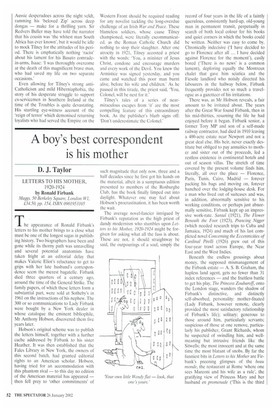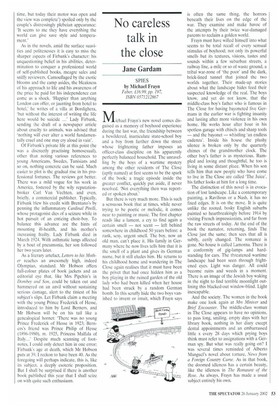A boy's best correspondent is his mother
D. J. Taylor
LETTERS TO HIS MOTHER, 1920-1924 by Ronald Firbank
Maggs, 50 Berkeley Square, London WI, £34.50, pp. 154, ISBN 0901953105
The appearance of Ronald Firbank's letters to his mother brings to a close what must be one of the longest sagas in publishing history. Two biographers have been and gone while its thorny path was unravelling and several potential anatomists have taken fright at an editorial delay that makes Valerie Eliot's reluctance to get to grips with her late husband's correspondence seem the merest bagatelle. Firbank died three quarters of a century ago, around the time of the General Strike. The family papers, of which these letters form a substantial part, were sold at Sotheby's in 1961 on the instructions of his nephew. The 300 or so communications to Lady Firbank were bought by a New York dealer in whose catalogue the eminent bibliophile, Mr Anthony Hobson, discovered them five years later.
Hobson's original scheme was to publish the letters himself, together with a further cache addressed by Firbank to his sister Heather. It was then established that the Fales Library in New York, the owners of this second batch, had granted editorial rights to an American scholar. Hobson, having tried for an accommodation with this phantom rival — to this day no edition of the American material has appeared — then fell prey to 'other commitments' of
such magnitude that only now, three and a half decades since he first got his hands on the material, albeit in a sumptuous edition presented to members of the Roxburghe Club, has the book finally limped out into daylight. Whatever one may feel about Hobson's procrastination, it has been worth the wait.
The average novel-fancier intrigued by Firbank's reputation as the high priest of dandy modernism who stumbles upon Letters to his Mother, 1920-1924 might be forgiven for asking what all the fuss is about. These are not, it should straightway be said, the outpourings of a soul, simply the record of four years in the life of a faintly querulous, consistently hard-up, old-young man in permanent transit, perpetually in search of both local colour for his books and quiet corners in which the books could be written. Neither was easy to come by. Chronically indecisive CI have decided to go to Florence after all ... I have decided against Florence for the moment'), easily bored (There is no news' is a common lament), deploring equally the Montreux chalet that gave him sciatica and the Fiesole landlord who noisily directed his labourers in the hallway below, Firbank frequently provides not so much a travelogue as a gazetteer of his irritations.
There was, as Mr Hobson reveals, a fair amount to be irritated about. The years after the Great War found Firbank, then in his mid-thirties, resuming the life he had enjoyed before it began. Firbank senior, a former Tory MP and son of a self-made railway contractor, had died in 1910 leaving a 400-acre estate near Newport and not a great deal else. His heir, never exactly destitute but obliged to pay annuities to mother and sister out of the proceeds, led a restless existence in continental hotels and out of season villas. The stretch of time covered by the present volume finds him, literally, all over the place — Florence, Paris, Tunis, Cairo, Madrid — forever packing his bags and moving on, forever hunched over the lodging-house desk. For a man who lived out of suitcases and was, in addition, abnormally sensitive to his working conditions, or perhaps just abnormally sensitive, Firbank kept up an impressive work-rate. Santa! (1921), The Flower Beneath the Foot (1923), Prancing Nigger (which needed research trips to Cuba and Jamaica, 1924) and much of his last completed novel Concerning the Eccentricities of Cardinal Pirelli (1926) grew out of this four-year trawl across Europe, the Near East and the West Indies.
Beneath the endless grousings about money, the supposed mismanagement of the Firbank estate — A. S. B. Graham, the hapless land agent, gets no fewer than 31 index references — and the fruitless battle to get his play, The Princess Zoubaroff, onto the London stage, wanders the shadow of Firbank's distinctive, and distinctly self-absorbed, personality: mother-fixated (Lady Firbank, however remote, clearly provided the most satisfactory relationship of Firbank's life); solitary; generous to those around him, particularly servants; suspicious of those at one remove, particularly his publisher, Grant Richards, whom he suspected of swindling him, and wellmeaning but intrusive friends like the Sitwells; the most innocent and at the same time the most blatant of snobs. By far the funniest bits in Letters to his Mother are Firbank's preening glimpses of the beau monde, the restaurant at Rome 'where one sees Marconi and his wife as a rule', the gratifying view of Princess Mary and her husband en promenade (This is the third
time, but today their motor was open and the view was complete') spoiled only by the couple's distressingly plebeian appearance: 'It seems to me they have everything the world can give save style and temperament.'
As in the novels, amid the surface suavities and politenesses it is easy to miss the sharper aspects of Firbank's character: his unquestioning belief in his abilities, determination to conquer a professional world of self-published books, meagre sales and sniffy reviewers. Camouflaged by the exotic blooms and the camp asides, the bleakness of his approach to life and his awareness of the price he paid for his independence can come as a shock. 'Happier than anything London can offer, or jaunting from hotel to hotel,' he writes of a villa at Bordighera, tut without the interest of writing the life here would be suicide ..,' Lady Firbank, sending the draft of a newspaper article about cruelty to animals, was advised that 'nothing will ever alter a world fundamentally cruel and one may cry aloud in vain'.
Of Firbank's private life at this point (he was a discreetly practising homosexual), other than noting various references to young Americans, Swedes, Tunisians and so on, nothing concrete can be said. Much easier to plot is the gradual rise in his professional fortunes. The reviews got better. There was a mild vogue for his work in America, fostered by the wily reputationbroker Carl Van Vechten, and even, briefly, a commercial publisher. Typically. Firbank blew his credit with Brentano's by penning the inflammatory Cardinal Pirelli, whose protagonist dies of a seizure while in hot pursuit of an enticing choir-boy. To balance this advance are the hints of mounting ill-health, and his mother's increasing frailty. Lady Firbank died in March 1924. With asthmatic lungs affected by a bout of pneumonia, her son followed her two years later.
As a literary artefact, Letters to his Mother reaches an awesomely high, indeed Olympian, standard. Mr Hobson offers full-colour plates of book jackets and an editorial eye that, like Mrs Pipchin's in Dornbey and Son, could be taken out and hammered on an anvil without sustaining serious damage, alert to the tiniest of his subject's slips. Let Firbank claim a meeting with the young Prince Frederick of Hesse, introduced to him by Lord Berners, and Mr Hobson will be on his tail like a genealogical hornet: 'There was no young Prince Frederick of Hesse in 1923; Berners's friend was Prince Philip of Hesse (1896-1980), m. 1925, Princess Malfala of Italy...' Despite much scanning of footnotes, I could only detect him in one error: Firbank's age at death, which Mr Hobson puts at 39, I reckon to have been 40. As the foregoing will perhaps indicate, this is, like its subject, a deeply esoteric proposition. But I shall be surprised if there is another book published this year that I shall seize on with quite such enthusiasm.



















































































 Previous page
Previous page